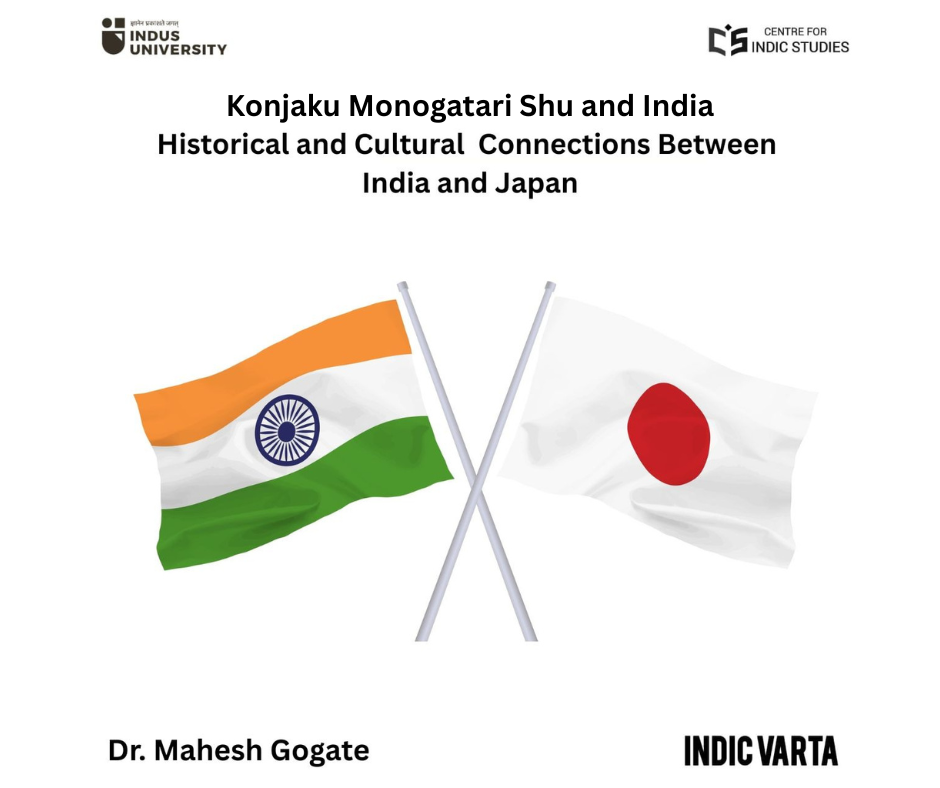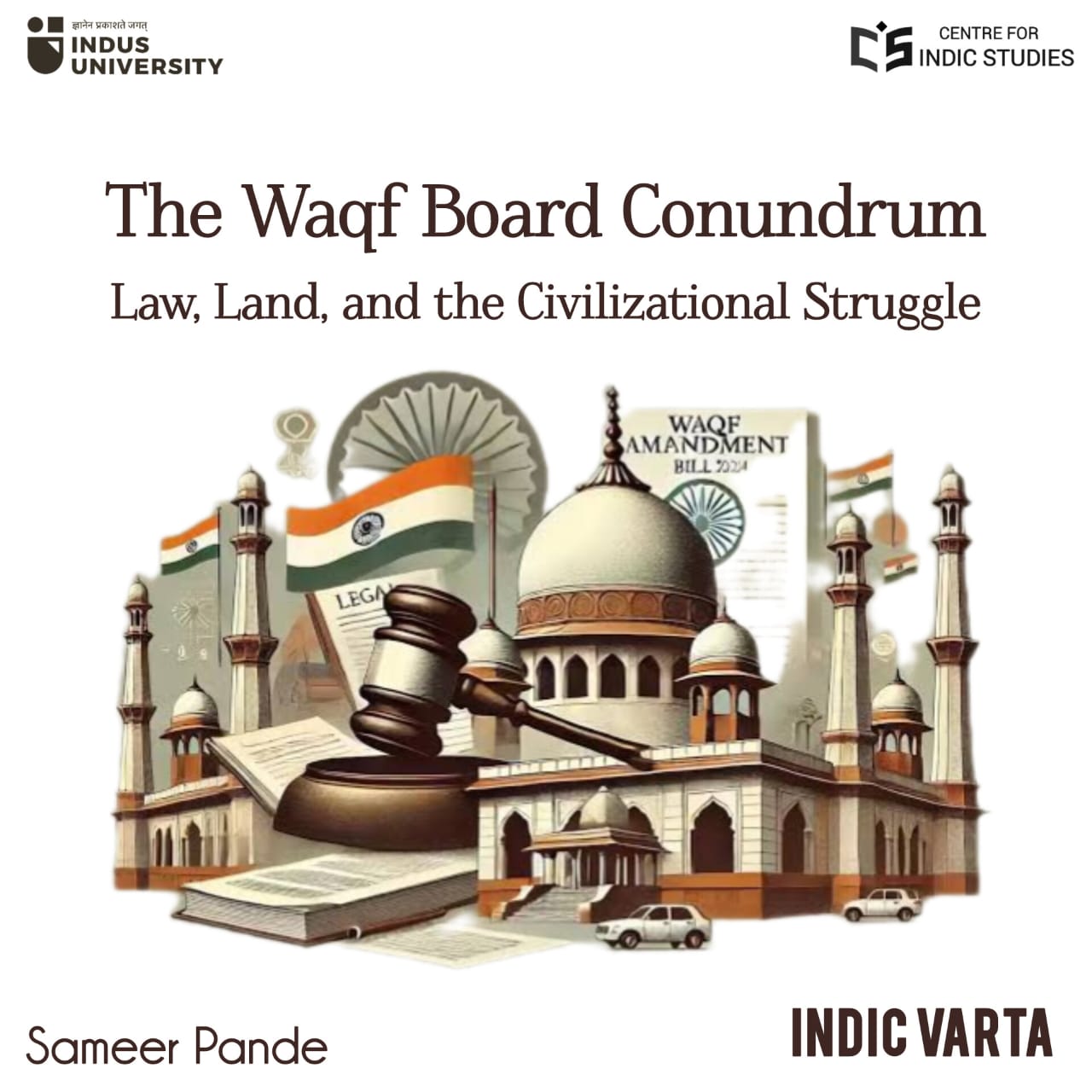- Visitor:33
- Published on: 2025-10-27 02:52 pm
Konjaku Monogatari Shu and India- Historical and Cultural Connections between India and Japan
The Konjaku Monogatari Shu (Collection of Tales of the Past), which was compiled during Japan’s late Heian period, is regarded as one of the most extensive and enigmatic works within the corpus of Setsuwa Bungaku (tale literature). Comprising a multitude of tales originating from India, China, and Japan, this collection remains a subject of scholarly intrigue due to its notable absence of a preface or postscript, and the continued uncertainty surrounding its authorship and date of compilation. Beyond its literary significance, the Konjaku Monogatari has attracted interdisciplinary attention from scholars in Japanese linguistics, Buddhist studies, and cultural history. The initial sections of the collection under scrutiny in this essay recount tales from the Indian subcontinent, thereby tracing the diffusion and adaptation of Indian cultural themes and ideas as they traversed Asia and were ultimately assimilated into Japan’s cultural and religious consciousness. The present essay examines the historical, cultural and literary interconnections between Indian tales and their Japanese reinterpretations within the Konjaku Monogatari, highlighting the complex pathways of trans-Asian cultural transmission between India and Japan.

Introduction
The Konjaku Monogatari Shu (今昔物語集 –Collection of Tales of the Past), widely regarded as one of Japan’s most distinguished and voluminous literary collections, was compiled during the late Heian period (around 1120). The Konjaku Monogatari belongs to the Setsuwa Bungaku, a tale literature category, and it comprises over thousands of tales from India, China, and Japan. Despite the passage of time, Konjaku Monogatari continues to be shrouded in mystery, primarily due to the presence of certain inconsistencies. This substantial literary work is devoid of a preface or postscript, and the circumstances surrounding its composition, including the author or authors, and time of composition remain unclear to this day.
Nevertheless, this compendium has attracted the attention of numerous Japanese and international scholars from fields beyond literary studies, including Japanese linguistics, Buddhist studies, and the history of the Japanese archipelago. The initial chapters were dedicated to stories originating from the Indian subcontinent. The chapters document the dissemination, transmission, and adaptation of Indian and Buddhist ideas and themes throughout Asia, concluding in their integration into the Japanese cultural consciousness. The present essay explores the profound historical, cultural and literary interplay between Indian narratives and their Japanese adaptations in the Konjaku Monogatari. This brief study demonstrates the far-reaching channels through which cultural transmission between India and Japan took place.
Historical Context and Settings
Konjaku Monogatari Shu (今昔物語集) has appeared in various English renderings, a testament to the inherent challenges of translating Japanese lexical items. The title itself is built from three components: konjaku (今昔), literally present and past; monogatari (物語), story or fable; and shu (集), collection or compilation. This, one of the largest and most diverse collection of 1,039 extant stories in a total of twenty-eight volumes (three volumes; 8, 18, and 21 have been lost), has been compiled in an encyclopedic style arguably to improve the metaphysical and social dimensions of its listeners. The lesser familiarity of Konjaku Monogatari among foreign readers in comparison to Genji Monogatari (The Tale of Genji) is also worthy of highlighting, despite the composition of these two literary works during the same period.
There are different claims about the period of its completion and about the author, who was supposed to be composing this huge literary work. Scholars like Smith (1966.222), Naito (1972. 9), and Kelsey (1982.11) have credited this work to Minato Takakuni (1004 –1077) who was an aristocrat and most likely completed this colossal work in 1075. Nevertheless, Kelsey also confirms that due to the absence of new evidence, it is very difficult to accurately identify the author and exact year of the completion. Smith tries to equate this work with the stories of Panchatantra and Jataka.
However, scholars like Kato (1979. 198) and Ury (1979.1-2) have rejected the notion of a single author and certainly not acknowledged this work to the Minato Takakuni. Ury, rather argues that the compiler may be a monk who probably belonged to the Tendai Sect of Japanese Buddhist Philosophy. Despite different claims, we can certainly assume that the work was completed around the end of the Heian period (794–1185), at the same time that aristocratic dominance started losing its importance. In the end of the eighth century, the capital was shifted from Nara to Nagaoka for a brief period and then to Heian or Heian-kyo (present day Kyoto).
Figure 1. Standing Bon-Ten (Brahma), Heian Period, 10th Century. Tokyo National Museum. Collection Reference Number: C-308. (Image is for reference purpose only) Source: ColBase: Integrated Collections Database of the National Institutes for Cultural Heritage, Japan. Link: https://colbase.nich.go.jp/collection_items/tnm/C-308?locale=en
Many Japanese scholars and priests embarked on risky sea voyages to China to learn and bring back these Esoteric teachings to Japan. During the Heian period, both the Tendai and Shingon sects received the support from imperial families and powerful aristocratic families. In this crucial period, the iconography, art, rituals, philosophies and ideas of Esoteric Buddhist teachings had great influence on Japanese people. Reciting prayers and incantations acquired importance during this period. Though the Shingon Sect never became a monolithic entity, and eventually disciples later formed their own temples with diverse styles and interpretations of Buddhist teachings. The Konjaku Monogatari is based on the Shingon Esoteric teachings and the stories reflect optimistic views about life. Konjaku Monogatari is widely regarded as the quintessential exemplar of realism in the realm of Japanese literature, offering a reflection of the turbulent and transitory era in which it was composed.
Figure 2. Konjaku Monogatarishū. Photograph courtesy: Main Library, Kyoto University, Kyoto, Japan. (Images is for reference purpose only, and the above image has been slightly edited for this paper). Please refer to the following link to view more images on this Website: https://rmda.kulib.kyoto-u.ac.jp/en/item/rb00000125.
Structure of the Konjaku Monogatari
The stories in Konjaku Monogatari cover many diverse subjects; from Buddhist tales to non-Buddhist tales. Each volume comprises groups of stories that share the same theme, with two adjacent stories being particularly interconnected. This approach ensures a systematic work structure that is meticulously classified to the finest level of detail.
The collection of Konjaku Monogatari is distinguished by a thoughtful implementation of geographical arrangement. The collection’s tales are classified into three geographical regions: the first five chapters are devoted to the tales of India (Tenjiku), the subsequent five chapters are the tales of China (Shintan), the next ten to Buddhist tales from Japan (Honcho), and the remaining chapters are more mundane and entertaining tales from Japan. This configuration is indicative of more than a mere spatial arrangement; it also reflects the historical diffusion path of Buddhist ideas, which can be described as follows: the Indian subcontinent as the source, China as the transmitter, and Japan as the inheritor and innovator. In the late Heian era, we do not find records that suggest the direct interaction between India and Japan; instead, knowledge about India arrived via Chinese translations, which were mediated by Korean intermediaries and filtered through a dense overlay of Chinese Buddhist interpretations.
Despite the geographical distance between the two regions, India was persistently conceptualized as the spiritual homeland of Buddha. This is due to the fact that India is regarded as a site of legend, authority and ultimate origin for Buddhist teachings and narratives. The collection of stories embodies a rich tapestry of narratives stemming from the ancient oral traditions of India.
The compilers of the diverse made frequent use of literary methods; abbreviation, addition and recontextualization. These methods allowed the compilers to retell the stories using Japanese cultural references and thematic elements that resonated with the Japanese audience. In the Jataka tales, a collection of Buddhist legends, there are numerous accounts of Buddha’s past lives in human and animal forms. In the opening chapter, the reader is introduced to the narrative of Shakyamuni Bodhisattva’s rebirth in the Jambudvipa. The text goes on to detail the homage paid to the Buddha by the deities Brahma and Indra at his birth. The subsequent narrative details Shakyamuni Tathagata’s visit to the Banaras (Varanasi–Kashi) region, wherein he delivered a sermon. These tales provided not only vivid parables of compassion, sacrifice, and wisdom, but also a cosmological rationale for Indian concepts of Karma and re-birth. For example, the story of ‘Tale of the Self-Sacrificing Rabbit’, a story found in numerous Buddhist traditions, is reinterpreted as a moral exemplar: the rabbit’s altruism, symbolized by its own body being offered as sustenance, becomes the paradigm of ultimate selflessness, illustrating the Buddhist ideal of infinite compassion.
Concluding remarks
By the time these stories reached the Japanese archipelago, they had already accumulated multiple layers of meaning through centuries of philosophical and cultural evolution. As demonstrated in the Konjaku Monogatari, the relocation of these tales from India to Japan exemplifies the inherently multi-layered and dynamic nature of cultural transmission. This is driven not merely by the physical movement of texts and ritual objects and practices, but by recurrent processes of adaptation, selection, and creative reinterpretation.
Appendix 1.
Japan – approximate time period with their titles
2. Kawakami, Chisato. 2021. The Konjaku Monogatarishū: Genesis, Structure, and Historical Context (in Japanese). Tokyo: Kachosha
3. Kelsey, W. Michael. 1982. Konjaku Monogatari-shū. Boston: Twayne Publishers. Morimoto, Yasuyoshi., and Kidd, David. (eds.). 1988. Shingon: Japanese Esoteric
4. Buddhism (by Yamasaki, Taiko; in Japanese): Peterson, Richard and Cynthia (translated). Boston and London: Shambhala Publications, Inc.
5. Naito, Hiroshi. 1972. Legends of Japan. Rutland, Vermont and Tokyo: Charles E. Tuttle Company.
6. Smith, Robert. 1966. “On Certain Tales of the Konjaku Monogatari as Reflections of Japanese Folk Religion”. Asian Folklore Studies. (pp. 221-233)
7. Ury, Marian. 1979. Tales of Times Now Past: Sixty-Two Stories from a Medieval Japanese Collection. Berkely: University of California.
- 16 min read
- 0
- 0










